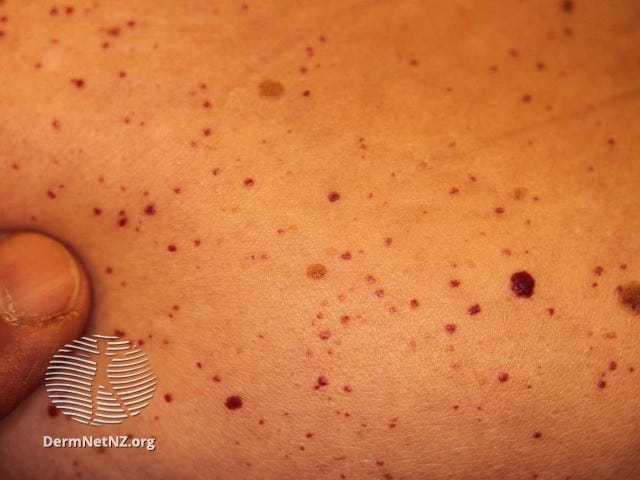Hello,
This week we have our first guest post. This post was written by Andrea Cortes, M.D., a clinical genetics fellow at University of Colorado. Thank you Andrea for your contribution!
Please feel free to email with any comments or questions about this post (daniel@studyrare.com). If you have ideas or want to contribute a post, feel free to send me an email.
Also, please share this post with anyone who might find it useful.
-Daniel
Questions
Question 45
A 52-year-old man with a past medical history of irritable bowel syndrome presents to the ER with shortness of breath. An echocardiogram shows left ventricular hypertrophy (LVH). Family history is notable for a maternal uncle who died at 45 years old after a kidney transplant and another maternal uncle with LVH. The physical exam is unremarkable. Urinalysis shows proteinuria. Genetic sequencing is sent and reveals the diagnosis of Fabry disease. How is this disease inherited?
Question 46
The patient in Question 45 has a deficiency in which of the following enzymes?
Explanation
Answers:
Q45: X-linked
Q46: Alpha-galactosidase A
The patient has Fabry disease, the only X-linked sphingolipidosis and the most common lysosomal storage disorder. Fabry disease results from deficient activity of the enzyme alpha-galactosidase A (α-Gal A) and causes progressive accumulation of globotriaosylceramide (Gb3) in lysosomes within cells throughout the body.

Fabry disease has two distinct types that are differentiated by clinical characteristics and enzyme activity. Classic Fabry disease is correlated with an α-Gal A enzyme activity < 1% and presents during childhood or adolescence with periodic crises of severe pain in the extremities (acroparesthesia; think “burning sensation in Fabry”), vascular cutaneous lesions (angiokeratomas), anhidrosis / hypohidrosis, corneal and lenticular opacities, and proteinuria. End-stage renal disease typically develops in men in their third to fifth decade. In middle age, males who have been successfully treated for end-stage renal disease may develop cardiac and/or cerebrovascular disease, which is a significant cause of morbidity and mortality. Symptoms in heterozygous females are usually milder and have a later onset compared to males.
In contrast, late-onset Fabry disease (LOFD) occur in males with > 1% α-Gal A enzyme activity. Clinical manifestations include cardiomyopathy (e.g. left ventricular hypertrophy) and proteinuria. Patients may also present with ESRD or a stroke or transient ischemic attack. Patients with LOFD often present without the skin lesions or episodic acroparesthesias associated with classic Fabry disease.
Diagnosis is made by measuring α-Gal A enzyme activity or by identification of a pathogenic variant in GLA on molecular genetic testing.

Management
Enzyme replacement therapy (ERT), sometimes combined with oral chaperone therapy such as migalastat, is available to slow down or prevent the progression of renal, cardiac, and cerebrovascular symptoms in Fabry disease. Agalsidase beta (Fabrazyme), an ERT and synthetic form of α-Gal A, can be administered intravenously. The latest guidelines for adults with Fabry disease recommend early initiation of ERT in all males with Fabry disease (including children) and in females who show clinical symptoms of the disease due to their high risk of renal, cardiac, and cerebrovascular complications. Depending on the organs affected, evaluation and treatment by specialists including cardiology, nephrology, and pain management may be required.
Incorrect answers
All of the 3 disorders discussed below are inherited in an autosomal recessive manner.
Arylsulfatase A is the enzyme deficient in metachromatic leukodystrophy, which presents with dementia and ataxia (“METAchromatic = MEmory loss + aTAxia”)
Hexosaminidase A is the enzyme deficient in Tay-Sachs disease, which presents with progressive neurodegeneration and developmental delay without hepatosplenomegaly.
Sphingomyelinase is the enzyme deficient in Niemann-Pick disease, which presents with progressive neurodegeneration and hepatosplenomegaly.
Learning Objective
Fabry disease is the only X-linked sphingolipidosis and results from deficient activity of the enzyme alpha-galactosidase A. Patients with late-onset Fabry disease may present with cardiomyopathy, renal disease, or cerebrovascular disease. Management includes ERT and/or oral chaperone therapy to decrease the rate of cerebrovascular, renal, and cardiac complications.
2023 ABMGG General Exam Blueprint | V. Single Gene Inheritance → d. Single Gene Disorders → ix. Metabolic disease (page 3) → 6. Lysosomal storage disorders
Tip: do not confuse alpha-galactosidase (Fabry disease) with beta-galactosidase (associated with GM1 and Morquio B)!
Additional Fabry-related resources
Fabry disease revisited: Management and treatment recommendations for adult patients (2018)
Fabry disease and the skin: data from FOS, the Fabry outcome survey (Brit J of Dermatology, 2017)
Developments in the treatment of Fabry disease (JIMD, 2020)






